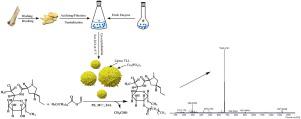当前位置:
X-MOL 学术
›
J. Ind. Eng. Chem.
›
论文详情
Our official English website, www.x-mol.net, welcomes your
feedback! (Note: you will need to create a separate account there.)
Green preparation of lipase@Ca3(PO4)2 hybrid nanoflowers using bone waste from food production for efficient synthesis of clindamycin palmitate
Journal of Industrial and Engineering Chemistry ( IF 5.9 ) Pub Date : 2020-09-01 , DOI: 10.1016/j.jiec.2020.06.007 Anming Wang , Xinxin Chen , Jianyun Yu , Ningning Li , Huimin Li , Youcheng Yin , Tian Xie , Stephen Gang Wu
Journal of Industrial and Engineering Chemistry ( IF 5.9 ) Pub Date : 2020-09-01 , DOI: 10.1016/j.jiec.2020.06.007 Anming Wang , Xinxin Chen , Jianyun Yu , Ningning Li , Huimin Li , Youcheng Yin , Tian Xie , Stephen Gang Wu

|
Abstract To prepare enzyme@Ca3(PO4)2 for environmentally friendly biocatalysis, Ca2+ and (PO4)3− were extracted from bone waste by acidification. In the nearly neutralized filtrate, the Ca2+ and (PO4)3− formed a Ca3(PO4)2 sediment that crystallized on a template of Thermomyces lanuginosus lipase (TLL) at 4 ℃ for 24 h, producing enzyme@Ca3(PO4)2-Bone hybrid nanoflowers (hNFs). Clindamycin palmitate was efficiently synthesized by transfer of a palmityl moiety from vinyl palmitate to clindamycin free base using these hNFs as a biocatalyst. At 30 ℃ in petroleum ether (PE) as the solvent, the yield of the TLL hNF-catalyzed reaction was as high as 70.0%. Even at a high temperature (80 ℃), the yield in the hNF-catalyzed reaction was still 52.6%, but no product was detected when using free lipase as the catalyst. Moreover, the hNFs retained 90% of their initial activity after 10 cycles (120 h, 12 h per cycle). This green and sustainable method that utilizes bone waste from food production as the raw source of the inorganic component was facile and efficient, and the system may also be applicable for preparing other enzyme@Ca3(PO4)2 hNFs for industrial applications.
中文翻译:

利用食品生产中的骨废料绿色制备脂肪酶@Ca3(PO4)2 杂化纳米花以有效合成克林霉素棕榈酸酯
摘要 为了制备用于环保生物催化的酶@Ca3(PO4)2,通过酸化从骨废料中提取Ca2+和(PO4)3−。在几乎中和的滤液中,Ca2+ 和 (PO4)3− 形成 Ca3(PO4)2 沉淀物,在 4 ℃ 24 小时内以绵毛嗜热丝孢菌脂肪酶 (TLL) 为模板结晶,产生酶@Ca3(PO4)2-骨混合纳米花(hNFs)。使用这些 hNF 作为生物催化剂,通过将棕榈基部分从棕榈酸乙烯酯转移到克林霉素游离碱,有效地合成了克林霉素棕榈酸酯。以石油醚(PE)为溶剂,在30℃下,TLL hNF催化反应的产率高达70.0%。即使在高温(80℃)下,hNF催化反应的产率仍为52.6%,但使用游离脂肪酶作为催化剂时未检出产物。而且,hNFs 在 10 个循环(120 小时,每个循环 12 小时)后保留了其初始活性的 90%。这种利用食品生产中产生的骨废料作为无机成分的原始来源的绿色可持续方法简单有效,该系统也可用于制备其他用于工业应用的酶@Ca3(PO4)2 hNFs。
更新日期:2020-09-01
中文翻译:

利用食品生产中的骨废料绿色制备脂肪酶@Ca3(PO4)2 杂化纳米花以有效合成克林霉素棕榈酸酯
摘要 为了制备用于环保生物催化的酶@Ca3(PO4)2,通过酸化从骨废料中提取Ca2+和(PO4)3−。在几乎中和的滤液中,Ca2+ 和 (PO4)3− 形成 Ca3(PO4)2 沉淀物,在 4 ℃ 24 小时内以绵毛嗜热丝孢菌脂肪酶 (TLL) 为模板结晶,产生酶@Ca3(PO4)2-骨混合纳米花(hNFs)。使用这些 hNF 作为生物催化剂,通过将棕榈基部分从棕榈酸乙烯酯转移到克林霉素游离碱,有效地合成了克林霉素棕榈酸酯。以石油醚(PE)为溶剂,在30℃下,TLL hNF催化反应的产率高达70.0%。即使在高温(80℃)下,hNF催化反应的产率仍为52.6%,但使用游离脂肪酶作为催化剂时未检出产物。而且,hNFs 在 10 个循环(120 小时,每个循环 12 小时)后保留了其初始活性的 90%。这种利用食品生产中产生的骨废料作为无机成分的原始来源的绿色可持续方法简单有效,该系统也可用于制备其他用于工业应用的酶@Ca3(PO4)2 hNFs。











































 京公网安备 11010802027423号
京公网安备 11010802027423号